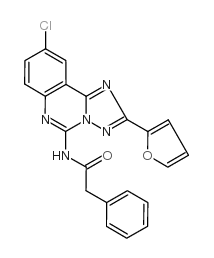MRS 1220

MRS 1220 structure
|
Common Name | MRS 1220 | ||
|---|---|---|---|---|
| CAS Number | 183721-15-5 | Molecular Weight | 403.82 | |
| Density | 1.49g/cm3 | Boiling Point | N/A | |
| Molecular Formula | C21H14ClN5O2 | Melting Point | N/A | |
| MSDS | Chinese USA | Flash Point | N/A | |
|
Fragment-Based Discovery of Subtype-Selective Adenosine Receptor Ligands from Homology Models.
J. Med. Chem. 58 , 9578-90, (2015) Fragment-based lead discovery (FBLD) holds great promise for drug discovery, but applications to G protein-coupled receptors (GPCRs) have been limited by a lack of sensitive screening techniques and scarce structural information. If virtual screening against ... |
|
|
Derivatives of the triazoloquinazoline adenosine antagonist (CGS15943) are selective for the human A3 receptor subtype.
J. Med. Chem. 39 , 4142-4148, (1996) The adenosine antagonist 9-chloro-2-(2-furanyl)[1,2,4]triazolo[1,5-c]quinazolin-5-amine (CGS15943) binds to human A3 receptors with high affinity (Ki = 14 nM), while it lacks affinity at rat A3 receptors. Acylated derivatives of the 5-amino group and other mo... |
|
|
Pharmacological characterization of novel A3 adenosine receptor-selective antagonists.
Neuropharmacology 36 , 1157-1165, (1997) The effects of putative A3 adenosine receptor antagonists of three diverse chemical classes (the flavonoid MRS 1067, the 6-phenyl-1,4-dihydropyridines MRS 1097 and MRS 1191, and the triazoloquinazoline MRS 1220) were characterized in receptor binding and func... |
|
|
Activation of hippocampal adenosine A3 receptors produces a desensitization of A1 receptor-mediated responses in rat hippocampus.
J. Neurosci. 17 , 607-614, (1997) The adenosine A3 receptor is expressed in brain, but the consequences of activation of this receptor on electrophysiological activity are unknown. We have characterized the actions of a selective adenosine A3 receptor agonist, 2-chloro-N6-(3-lodobenzyl)-adeno... |
|
|
The PI3K-NF-kappaB signal transduction pathway is involved in mediating the anti-inflammatory effect of IB-MECA in adjuvant-induced arthritis.
Arthritis. Res. Ther. 8 , R33, (2006) The anti-inflammatory effect of adenosine was previously found to be mediated via activation of the A3 adenosine receptor (A3AR). The aim of the present study was to decipher the molecular mechanism involved with the inhibitory effect of IB-MECA, an A3AR agon... |
|
|
Naunyn Schmiedebergs Arch. Pharmacol. 364 , 225-234., (2000)
|